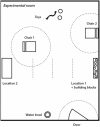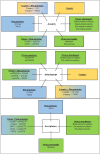Dog-Owner Attachment Is Associated With Oxytocin Receptor Gene Polymorphisms in Both Parties. A Comparative Study on Austrian and Hungarian Border Collies
- PMID: 29674985
- PMCID: PMC5895926
- DOI: 10.3389/fpsyg.2018.00435
Dog-Owner Attachment Is Associated With Oxytocin Receptor Gene Polymorphisms in Both Parties. A Comparative Study on Austrian and Hungarian Border Collies
Abstract
Variations in human infants' attachment behavior are associated with single nucleotide polymorphisms (SNPs) in the oxytocin receptor (OXTR) gene, suggesting a genetic component to infant-mother attachment. However, due to the genetic relatedness of infants and their mothers, it is difficult to separate the genetic effects of infants' OXTR genotype from the environmental effects of mothers' genotype possibly affecting their parental behavior. The apparent functional analogy between child-parent and dog-owner relationship, however, offers a way to disentangle the effects of these factors because pet dogs are not genetically related to their caregivers. In the present study we investigated whether single nucleotide polymorphisms of pet dogs' OXTR gene (-213AG,-94TC,-74CG) and their owners' OXTR gene (rs53576, rs1042778, rs2254298) are associated with components of dog-owner attachment. In order to investigate whether social-environmental effects modulate the potential genetic influence on attachment, dogs and their owners from two different countries (Austria and Hungary, N = 135 in total) were tested in a modified version of the Ainsworth Strange Situation Test (SST) and questionnaires were also used to collect information about owner personality and attachment style. We coded variables related to three components of attachment behavior in dogs: their sensitivity to the separation from and interaction with the owner (Attachment), stress caused by the unfamiliar environment (Anxiety), and their responsiveness to the stranger (Acceptance). We found that (1) dogs' behavior was significantly associated with polymorphisms in both dogs' and owners' OXTR gene, (2) SNPs in dogs' and owners' OXTR gene interactively influenced dog-human relationship, (3) dogs' attachment behavior was affected by the country of origin, and (4) it was related to their owners' personality as well as attachment style. Thus, the present study provides evidence, for the first time, that both genetic variation in the OXTR gene and various aspects of pet dogs' environmental background are associated with their attachment to their human caregivers.
Keywords: attachment; dog (Canis familiaris); owner; oxytocin; personality; relationship.
Figures



Similar articles
-
Influence of owners' attachment style and personality on their dogs' (Canis familiaris) separation-related disorder.PLoS One. 2015 Feb 23;10(2):e0118375. doi: 10.1371/journal.pone.0118375. eCollection 2015. PLoS One. 2015. PMID: 25706147 Free PMC article.
-
Physiological Indicators of Attachment in Domestic Dogs (Canis familiaris) and Their Owners in the Strange Situation Test.Front Behav Neurosci. 2019 Jul 23;13:162. doi: 10.3389/fnbeh.2019.00162. eCollection 2019. Front Behav Neurosci. 2019. PMID: 31396061 Free PMC article.
-
Social Behavior of Pet Dogs Is Associated with Peripheral OXTR Methylation.Front Psychol. 2017 Apr 10;8:549. doi: 10.3389/fpsyg.2017.00549. eCollection 2017. Front Psychol. 2017. PMID: 28443051 Free PMC article.
-
Oxytocin receptors (OXTR) and early parental care: An interaction that modulates psychiatric disorders.Res Dev Disabil. 2018 Nov;82:27-38. doi: 10.1016/j.ridd.2017.10.007. Epub 2017 Oct 21. Res Dev Disabil. 2018. PMID: 29033100 Review.
-
Review of eating disorders and oxytocin receptor polymorphisms.J Eat Disord. 2021 Jul 13;9(1):85. doi: 10.1186/s40337-021-00438-0. J Eat Disord. 2021. PMID: 34256847 Free PMC article. Review.
Cited by
-
Effect of Intranasal Oxytocin Administration on Human-Directed Social Behaviors in Shelter and Pet Dogs.Front Psychol. 2018 Nov 16;9:2227. doi: 10.3389/fpsyg.2018.02227. eCollection 2018. Front Psychol. 2018. PMID: 30524337 Free PMC article.
-
Human Preferences for Dogs and Cats in China: The Current Situation and Influencing Factors of Watching Online Videos and Pet Ownership.Animals (Basel). 2024 Nov 29;14(23):3458. doi: 10.3390/ani14233458. Animals (Basel). 2024. PMID: 39682424 Free PMC article.
-
Dog-Owner Relationship, Owner Interpretations and Dog Personality Are Connected with the Emotional Reactivity of Dogs.Animals (Basel). 2022 May 24;12(11):1338. doi: 10.3390/ani12111338. Animals (Basel). 2022. PMID: 35681804 Free PMC article.
-
Variability in Human-Animal Interaction Research.Front Vet Sci. 2021 Jan 15;7:619600. doi: 10.3389/fvets.2020.619600. eCollection 2020. Front Vet Sci. 2021. PMID: 33521092 Free PMC article. Review.
-
The Influence of Oxytocin on Maternal Care in Lactating Dogs.Animals (Basel). 2021 Apr 15;11(4):1130. doi: 10.3390/ani11041130. Animals (Basel). 2021. PMID: 33920905 Free PMC article.
References
-
- Ainsworth M. D., Blehar D. S., Waters E., Wall S. (1978). Patterns of Attachment: A Psychological Study of the Strange Situation. Oxford, UK: Lawrence Erlbaum.
-
- Arahori M., Hori Y., Saito A., Chijiiwa H., Takagi S., Ito Y., et al. (2016). The oxytocin receptor gene (OXTR) polymorphism in cats (Felis catus) is associated with “Roughness” assessed by owners. J. Vet. Behav. Clin. Appl. Res. 11, 109–112. 10.1016/j.jveb.2015.07.039 - DOI
-
- Beck L., Madresh E. A. (2008). Romantic partners and four-legged friends: an extension of attachment theory to relationships with pets. Anthrozoos 21, 43–56. 10.2752/089279308X274056 - DOI
LinkOut - more resources
Full Text Sources
Other Literature Sources

